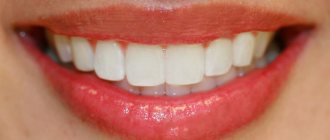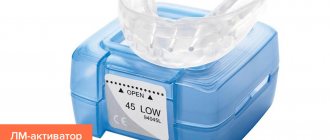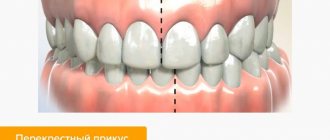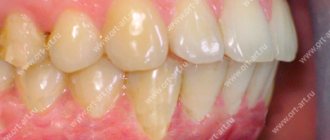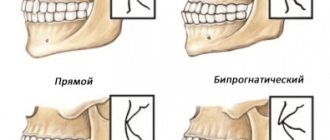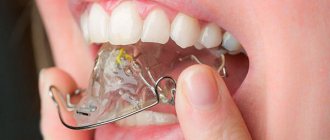Bite defects are not as rare a problem as it might seem. Medical statistics show that every third person has malocclusion in one form or another! If the anomaly is serious and noticeable, it is corrected in adolescence, but people are in no hurry to deal with mild crooked teeth. And most often because they don’t want to wear braces that others can easily see.
But modern dentistry is ready to offer patients an alternative to braces - these are transparent aligners, wearing which can help correct the bite and acquire a beautiful smile. At the same time, your treatment will remain invisible to strangers and will not cause you any discomfort!
In the article we will talk in detail about how bite defects are treated with mouth guards, what are its features, what types of mouth guards exist and how long they will have to be worn in order to straighten the teeth and acquire an attractive smile.
What are orthodontic aligners, indications for use
The aligners also have a second name - aligners. At their core, they are soft and transparent overlays for teeth, which are made from hypoallergenic polymer materials. Mouthguards, unlike braces, are removable structures: you can put them on and take them off yourself, without visiting the orthodontist’s office.
The mechanism of the beneficial action of mouth guards for correcting occlusion is as follows: the design completely covers the jaw arch and creates pressure on the areas of the dentition that need correction. The main advantage of orthodontic aligners is convenience. Wearing them does not cause any discomfort, adaptation to them is quick, and when correcting a bite with mouth guards, there is no need to follow a diet that excludes any food products.
When can mouth guards be used to correct a bite? Indications for the use of orthodontic aligners are as follows:
- The presence of noticeable interdental spaces;
- Slight displacement of individual teeth in a row;
- Slight crowding of teeth;
- Poor open, cross or distal bite.
IMPORTANT: Unfortunately, serious malocclusion cannot be corrected with mouthguards. To correct significant pathologies, braces are used, most often metal ones, which can create strong pressure on the teeth and thereby bring them into the correct position.
Take a short test and calculate the cost of treatment!
Take a short test
- Jaw selection
- Availability of photo
- Selecting a brace system
- Date of treatment
- Cost calculation
×
Manukyan Artavazd Genrikovich
Chief physician of the clinic
In what cases is effectiveness demonstrated?
Despite all the positive qualities and advantages of aligners, they are not omnipotent. Mouth guards are indicated for use for leveling minor bite pathologies, or as a supportive means after removing the braces.
For advanced deformities or serious disorders, they are ineffective.
This is why the decision about the choice of treatment method should always be made by the orthodontist. Only he can determine the advisability of installing mouth guards and predict the result of the correction.
For more accurate diagnosis and choice of methodology, 3D computer modeling should be used; this will minimize the likelihood of error and allow you to create the most effective design.
How is a bite corrected using mouthguards?
Correcting a bite with mouth guards begins with a visit to the orthodontist's office. During the first appointment, the doctor examines the oral cavity, assesses the correctness of the bite, and additional diagnostic measures may be prescribed - for example, a panoramic photograph of the jaw. A detailed diagnosis before starting orthodontic treatment and bite correction will help the orthodontist choose the most effective correction method for a specific clinical case.
If the diagnosis shows that in your case it is possible to correct the bite with mouthguards, then further treatment will proceed according to the following scheme:
1. Professional oral hygiene will be carried out, necessary for high-quality cleaning of teeth from plaque and tartar.
2. Impressions are taken of the teeth, on the basis of which a plaster model of the patient’s jaws is made.
3. Mouthguards are created using the finished plaster model. Aligners are made not as a single copy, but as a whole set. You will change mouthguards to correct your bite according to the scheme that the orthodontist will develop for you. Changing the aligners is required to create the correct pressure on the teeth, which will promote their displacement and alignment.
IMPORTANT: The effectiveness of correcting your bite with mouthguards will largely depend on your attitude towards treatment. Mouthguards must be worn for at least 20-22 hours. If you break this rule, you may not expect a positive result from bite correction!
Braces or mouthguards - which is better?
So, what should you choose - mouth guards or braces to straighten your teeth? This depends on several factors, the main one being medical indications. Let us list once again the main advantages and disadvantages of braces and mouthguards.
Pros of braces:
- high efficiency;
- suitable for almost any pathology;
- relatively low cost.
Cons of braces:
- long installation;
- difficulty of care;
- unaesthetic;
- long-term adaptation.
Pros of the mouth guard:
- aesthetics;
- do not impair diction;
- no diet;
- simple hygiene rules;
- hypoallergenic.
Cons of the mouth guard:
- high cost;
- not suitable for all disorders;
- long production;
- risk of loss.
Another important factor to consider when choosing a malocclusion correction method is related to motivation. You need to prepare for the fact that after installing braces or mouth guards there will be discomfort and even pain. You need to be patient for a little while so that the oral cavity gets used to the foreign object. A person who is prescribed aligners may want to remove them. Over time, he will do this more and more often, and because of this, the effectiveness of the treatment decreases. It can last for several years without bringing any results. Braces in this context have an important advantage: they cannot be removed by yourself, so you will have to come to terms with and comply with the orthodontist’s requirements.
How many trays may be needed to correct a bite?
How many trays are included in the bite correction kit? The answer to this question will depend on two main factors:
- Difficulties in malocclusion that needs to be corrected;
- Patient's age. The older a person is, the longer orthodontic treatment can be, because after the final formation of the dental system, tooth displacement occurs more slowly. That’s why dentists recommend correcting your bite in childhood and adolescence!
Thus, a full course may require about 15-40 pairs of mouth guards, and each mouth guard will have its own shape and size. To correct the bite, the mouthguards are changed every 2-3 weeks.
Regular change of aligners when correcting a bite is necessary: it allows you to achieve the tightest possible fit of the structure to the teeth. Due to the high density of the mouth guards, they will exert pressure on the teeth, which will cause the teeth to shift in the desired direction. As soon as the pressure becomes insignificant, the used mouth guards are replaced with a new pair.
Briefly about bruxism
At the subconscious level, a person imitates chewing movements in a dream, but is not able to control the force of clenching of the jaws. This often leads to hyper-wear of tooth enamel and the possibility of tooth loss. The causes of bruxism are considered:
- poor sleep;
- nervousness and constant stress;
- bad habits;
- disorders of the gastrointestinal tract.
There is an alternative to mouthguards. These are Botox injections, but this technique does not guarantee a 100% effect.
Dentists advise not to save money and buy a night guard for your teeth, because with its help you can:
- prevent tooth displacement;
- carry out prevention of changes in bite;
- protect against chips and cracks in enamel layers;
- preserve orthodontic structures, if installed in the patient’s mouth.
In addition, bruxism has dangerous consequences. It often causes migraines, neck and back pain, and sometimes leads to sleep apnea.
Types of mouthguards for correcting bite
Orthodontic mouthguards for correcting bites have their own classification. They are divided into different types according to the following characteristics:
— Material of production. Mouthguards for correcting bites can be made of silicone or polyester;
- Production technology. On this basis, standard and individual dental guards are distinguished.
Each type of mouthguard for correcting the bite has its own characteristics, which will be useful for people planning to undergo orthodontic treatment.
How to wear mouth guards after braces without damaging them?
Mouthguards are made of plastic material, so they can be easily damaged if handled carelessly. In this case, the device will no longer perform its main task - to hold the teeth in the correct position. If it breaks, it cannot be repaired; a new one will have to be made. Therefore, it is important to follow the rules of safe operation.
How to wear a mouthguard correctly:
- To avoid damage, it must be removed before each meal.
- Plastic aligners do not withstand high temperatures well, so you should not drink hot tea, coffee or other drinks with an orthodontic structure in your mouth.
- Between uses, the mouthguards are worn like other personal care products - in special lockable containers. This protects the device from contamination and damage.
- You cannot smoke with a mouth guard in your mouth, because tobacco smoke and tar change the color and structure of the material. The mouth guard becomes cloudy and less flexible.
- The structure is stored at room temperature. Both heat and cold negatively affect its characteristics.
Customized dental guards
This is the best option for correcting malocclusion, because such mouthguards are made individually for each patient and based on impressions of his teeth. This allows you to ensure maximum tightness of fit of the trays to the teeth.
Individual mouth guards for correcting occlusion are made from silicone - a plastic, hypoallergenic and transparent material, so the designs will be comfortable to wear and completely invisible on dental surfaces. One of the most popular options for customized mouth guards for correcting malocclusion is the Invisalign system. But they are not made from silicone, but from a biopolymer and sufficiently rigid material. We will talk in detail about Invisalign mouth guards for correcting bites in a separate section of our article.
What is more effective
The task of mouthguards and braces is the same - to correct the bite and straighten the teeth. Aligners became known only 20 years ago, but are already very popular among doctors and patients. These designs are chosen as often as braces. An aligner is a plate that is placed over your teeth. It is impossible to say exactly which brand of mouth guards is best. Treatment with all models of structures gives excellent results. The only difference is the price. Correction with aligners is comfortable and painless.
Sign up for free 3D modeling of your future smile!
Make an appointment
*By making an appointment you consent to the processing of your data
It only takes a few days to adapt. A significant advantage of aligners is invisibility. If you want to hide the use of a corrective structure, choose mouth guards. A lingual brace system, which is attached to the inside of the teeth, is also suitable.
When wearing metal systems, the treatment will last a little less. They do not change color, are durable and comfortable. The only disadvantage of metal braces is that they cannot be hidden from the eyes of others. But there is a way out. In this case, ceramic or sapphire models are suitable for you. When a patient comes to the Propricus clinic, the orthodontist offers him several correction options. The doctor talks about the features of each method, all the pros and cons. Our task is to help make an informed choice, a method of bite alignment that suits the patient’s priorities and capabilities.
Invisalign aligners for correcting malocclusion
Invisalign aligners are a set of designs, the number of which is determined for each patient individually. The more complex the bite defect that needs to be corrected, the more number of trays will be made for a full course of correction. Unlike other types of aligners, Invisalign aligners can also be used to correct complex malocclusions, such as straight and medial bites.
Invisalign aligners are made to correct the bite using a 3D model of the jaws, which is created by a computer program. The use of computer technology allows not only to obtain anatomically accurate orthodontic structures for effective treatment, but also to show the patient the final result of the correction.
The three-dimensional model and impressions are sent to a laboratory in the USA, where a full set of mouth guards is manufactured to correct the bite. When the kit is ready, the patient is invited to the clinic, where the orthodontist gives detailed advice on wearing the aligners and caring for them.
Invisalign mouth guards are one of the most expensive types of aligners; the total cost of a course of treatment starts at 400,000 rubles. However, these are the most convenient and effective mouth guards to use and, importantly, are invisible on dental surfaces. This quality of Invisalign aligners is especially appreciated by adult patients.
You can get detailed advice on Invisalign aligners and their use in bite correction at our premium dentistry clinic in Moscow - “Aesthetica”. Making an appointment with our dental specialists is very simple: you can do this through a special form on the website or by dialing our contact phone number. "Aesthetica" - advanced technologies for the health of your teeth and the beauty of your smile!
Manufacturing
During the preparation, the doctor cleans the little patient’s teeth with ultrasound and, if necessary, treats caries to eliminate sources of infection in the mouth. After this, an impression of the dentition is taken and an X-ray is taken.
In the manufacturer’s laboratory, using computer software, they create a virtual model of the aligners, program the movement of the teeth and the final result. Then a set of individual plates is made using this model. The whole process takes 1-2 weeks. During the fitting, the doctor tells the child and parents how to use and care for the mouth guards.
Advantages and disadvantages of using mouth guards to correct bites
Mouthguards for correcting bites have a number of advantages that make orthodontic treatment comfortable and convenient for patients:
— Mouthguards are removable structures, and this provides a number of advantages. Firstly, the mouth guard can be easily removed before an important meeting or special event, and secondly, this allows for high-quality oral hygiene and comfortable eating. You simply remove the mouth guard while eating for quality cleansing;
— The process of adaptation to mouth guards for correcting malocclusion proceeds quite quickly. In just 2-3 days you will stop noticing the aligners on your teeth;
— Wearing aligners does not cause problems with diction and does not interfere with active communication;
— The elastic material of the mouth guard does not injure the soft tissues of the oral cavity, does not cause allergic reactions and does not have a negative effect on tooth enamel;
— Mouthguards for correcting bites are made from transparent materials and therefore they are invisible on the teeth;
— The structures are easily cleaned from food debris and plaque;
— Correcting your bite with mouth guards can be combined with teeth whitening: to do this, just apply a special whitening gel to the inner surface of the product.
Treatment of bite defects with mouthguards is possible at any age and has fewer indications than therapy using traditional braces. But in addition to the advantages, mouth guards for correcting bites also have some disadvantages that are important to consider before starting treatment.
Among them:
— Mouthguards cannot correct serious malocclusions;
— It will take a long time to produce a full set of mouth guards to correct your bite.
It is worth noting that the price of correcting a bite with aligners may be more expensive than treatment with braces.
Trainers for children
Trainers are mainly used at an early age - from 3 to 9 years, during the period of baby teeth and mixed dentition. They correct defects in the development of the dental system associated with various dysfunctions.
Often problems with bite are complex, for example associated with improper breathing. In particular, a small child may have enlarged adenoids, he cannot breathe fully through his nose and uses his mouth to do this. If this continues for a long time, then a number of problems arise.
- The upper jaw is formed incorrectly - it narrows in the lateral sections, as a result there is not enough space for the eruption of permanent teeth.
- Improper development of the upper jaw causes developmental defects in the lower jaw, and diction suffers from this.
- The muscles of the lips, tongue, and cheeks also do not work correctly, which negatively affects the aesthetics of the face: the neck is pulled forward, the lower third of the face lengthens, and the middle zone is poorly developed.
- The child cannot swallow fully, which affects digestion.
In this case, the orthodontist may recommend wearing trainers - they help the eruption of permanent teeth, develop the muscles of the oral cavity, help restore proper breathing, and shape posture. These mouthguards are worn during the day for several hours and throughout the night. The treatment process can be supplemented with developmental exercises.
Rules for wearing and caring for mouth guards to correct your bite
There is nothing complicated about caring for mouth guards to correct your bite. All you need to do is:
1. Remove the mouth guards from your mouth while eating and each time after removal, rinse them in clean, cool water. 2. After removing the aligners and before putting the aligners back on, carefully and efficiently brush your teeth to remove plaque and food debris. In this procedure, it is recommended to use not only a brush and toothpaste, but also dental floss and rinses. 3. The outer surface of the trays to correct the bite should be cleaned with a soft brush and paste. 4. Aligners should be stored in a special container. 5. If you accidentally damage the mouthguard, it should be replaced with a new pair. 6. Mouthguards cannot be bent, washed with aggressive substances or just hot water.
And of course, don’t forget that mouth guards only work to correct your bite if you wear them regularly and at least 20 hours a day.
Wearing comfort
You need to get used to braces and mouth guards. The adaptation period after installation of orthodontic structures lasts about 5-15 days. At this time, the patient may experience discomfort and pain. In addition, there is a risk that metal structures will rub the mucous membrane, in rare cases this leads to the development of inflammation of the soft tissues. Braces also have a significant impact on diction, especially at the very beginning of wearing them. Even lingual braces cause speech distortion. Each time after tightening the arch there will be a new period of adaptation, but not as long as the first.
Mouthguards are much more comfortable, they do not rub the oral mucosa and do not lead to deterioration of diction. However, trainers significantly increase the size of the teeth, which is accompanied by mild discomfort. They usually get used to it quickly. During this period, it is important to be patient and not remove the mouth guards several times a day, otherwise the treatment will be delayed.
Duration and effectiveness of treatment with mouthguards for correcting malocclusion
The timing of treatment will depend primarily on the complexity of the malocclusion that needs to be corrected. The average duration of aligner therapy in adult patients is 1 year. This is taking into account your disciplined approach to treatment! The orthodontist will definitely calculate the approximate time frame for the general course of correction when drawing up a treatment plan!
Mouthguards for correcting bites are effective in correcting mild anomalies; if you need to eliminate severe crowding of teeth or serious pathology, it is optimal to plan treatment using classic braces.
Silicone aligners for teeth straightening
Treatment with clear aligners minimizes the risk of medical error. The fact is that while wearing braces, the dentist takes a very active part and is independently involved in their installation and corrections, and in the process he may make a mistake. As a result, the course of treatment and, as a consequence, its outcome may be disrupted. In addition, during the next correction, there is a risk of “tightening” the ligature, which can cause severe pain and “eversion” of the roots of the teeth. A transparent mouthguard for straightening teeth for adults acts on hard tissues very smoothly and, if the doctor initially correctly calculated the trajectory of teeth movement, cannot disrupt the course of treatment.
Price for mouthguards to correct bite
The total cost of a course of bite correction with aligners will depend on the length of treatment and the number of aligners that will need to be made. In addition to the price of the aligners themselves, it is worth considering additional procedures that may need to be performed before starting orthodontic treatment. Thus, mouthguards should not be worn if you have caries, gum disease, or poor oral hygiene. Diagnostics, photographs and casts of the jaw are paid separately. Therefore, the exact cost of a course of treatment with mouth guards to correct your bite can only be calculated for you in the orthodontist’s office.
If you are thinking about correcting your bite, come to our clinic in Moscow - “Aesthetica”! Our experienced orthodontists will definitely select the treatment method that will be most effective in your case! We offer our patients the best technologies, materials, individual approach and guarantee that with us you can treat your teeth and get a beautiful smile in a comfortable environment and without pain!
Features of treatment
Orthodontic aligners are supplied in kits, they are individually made for the patient and labeled in the order of use. The patient changes aligners to subsequent ones after the doctor's permission or on a predetermined schedule. Periodically, he visits the orthodontist for examination and control over bite correction. To correct the bite, daily mouth guards are used (they are worn constantly, removed only for cleaning and eating). When the results of treatment are consolidated or there are minor malocclusions, it is possible to use night aligners (the patient wears them while sleeping).
Dentists at the Dentospas clinic recommend:
- Rinse the trays regularly and clean them with an antiseptic. However, they should not be exposed to high temperatures (washed in very hot water), this can damage them;
- when worn, the enamel surface is not washed with saliva and is less easily cleaned, therefore, high-quality hygiene is especially important during treatment;
- the structures are removed during meals;
- During orthodontic treatment, it is better to stop smoking: because of it, the transparent material can change its color, become yellow or cloudy, and lose elasticity. Contact with coloring or acidic drinks is not recommended;
- If the mouthguard has been damaged (it is torn, a crack has appeared on it, etc.), it cannot be used. You need to see an orthodontist for a replacement.
Bite correction with orthodontic aligners takes from several months to two years. You can more accurately determine the duration of treatment or calculate its price at a free consultation with an orthodontist at the Dentospas clinic.

